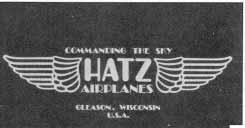Here's a pirep of one of my very
favorite little biplanes. It's a lot of work to build, but simple
as a Cub, both in it's structure and its personality. And it just
oozes fun!
Biplane! The very word conjures up images of endless
flat, checkerboard fields, their color bleeding off to horizons so
distant it is almost possible to see the Earth’s curvature
through the maze of clustered wires and struts. The image conjured
up by he word is almost never that of a modern biplane, such as a
Pitts or Starduster, but is of some generic oldster that comprises
little of today, but lots of yesterday. Biplanes of the mind are
soft, friendly, lifting contraptions happy to call hay fields home
and make every pilot feel comfortable and wanted.
As soon as the term “homebuilt” was put in front of he
word “biplane,” the
imaged changed drastically. The soft, forgiving image became one of
extreme maneuverability and hockey-puck sink rates, or richochetting
off the runway and having the mouth dry out on final. Homebuilt biplanes
are one breed and biplanes of the old school were quite another.
 |
It's really a crime
that John Hatz didn't live to see how popular his little
airplane has become. |
That all changed with the introduction of the Hatz
Biplane in the early 1970’s, but it wasn’t until Oshkosh 1990 that the full
impact and style of the Hatz concept was felt by the rest of the homebuilt
movement. Although the grand champion custom built of 1986 was Rich
Hansen’s masterful rendition of a Hatz, very few of the airplanes
were seen by the general aviation population. Oshkosh remedied that
situation when the Hatz contingent decided to waft into town en mass
and t least six variations on the Hatz theme were on the field for
all to examine.
As along time lover of things with two wings, I realized I was missing
something by not becoming acquainted with the oldish appearing bipester.
It wasn’t until this year, when I approached Frank Pavliga of
Alliance, Ohio, that things actually came together and I was able to
make the airplanes acquaintance. It is to Rich Hansen’s credit
that he directed me to Frank and Jim Hanna because he felt as if
his airplane had received more than its fair share of attention,
as past grand champion. He wanted folks to know there was more than
just one Hatz flying around.
The next morning, when I approached Frank's airplane, I could see
Rich had made a good decision. Even the most casual examination
showed his machine to be a study in the attention to detail which
is so essential in producing an outstanding homebuilt — or anything
for that matter. As it happens, Frank comes by the attention to detail
honestly since he and his dad, Frank Sr., have been building Pietenpols
for many years. As they put it, "We were looking for something
with the soul of the Pietenpol and the Hatz appeared to be a biplane
Pietenpol.
In looking back on the building of the airplane, Frank says little
was difficult, with the possible exception of trying to keep it a
secret from his father. He wanted to surprise him so, for the first
three years, his father had no idea there was a new project in his
son's shop — even though they lived only 50 miles apart. When
the airplane had the raw covering on, Frank Jr. assembled the airplane
in his drive and invited his dad over for dinner. From that point
on, Sr. became a vital part of the airplane's progress as he pitched
in to help with every aspect of the finishing work.
Frank said the airplane presented absolutely no unusual building
challenges other than the sheer task of building four wing panels that
big. With a wing span of 25 ft 4 in, although the parts are far from
being complicated, there are lots to be made and stuck together. Of
the four years consumed in the construction, half that time was spent
on the wings.
GO TO NEXT
PAGE
|

